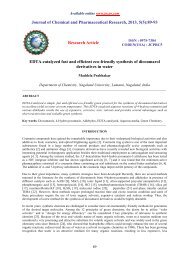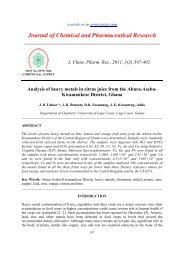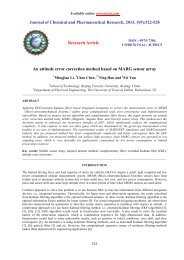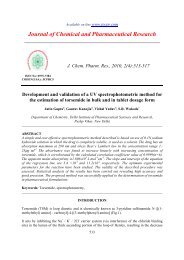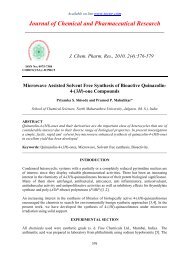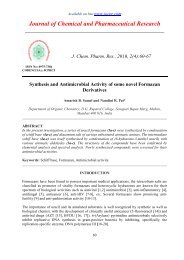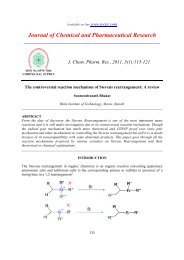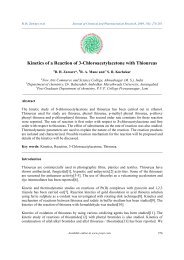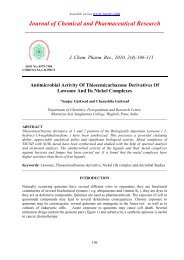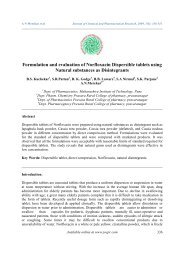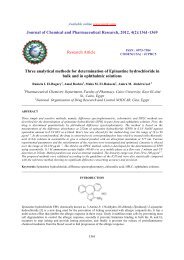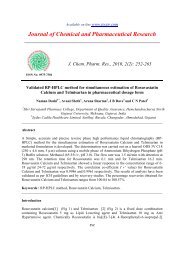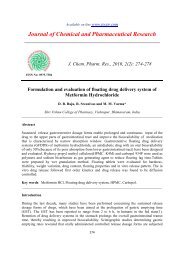Effect of Zinc and Sulphur on herb, oil yield and quality - Journal of ...
Effect of Zinc and Sulphur on herb, oil yield and quality - Journal of ...
Effect of Zinc and Sulphur on herb, oil yield and quality - Journal of ...
Create successful ePaper yourself
Turn your PDF publications into a flip-book with our unique Google optimized e-Paper software.
Available <strong>on</strong> line www.jocpr.com<strong>Journal</strong> <str<strong>on</strong>g>of</str<strong>on</strong>g> Chemical <str<strong>on</strong>g>and</str<strong>on</strong>g> Pharmaceutical Research__________________________________________________J. Chem. Pharm. Res., 2010, 2(4):642-648ISSN No: 0975-7384CODEN(USA): JCPRC5<str<strong>on</strong>g>Effect</str<strong>on</strong>g> <str<strong>on</strong>g>of</str<strong>on</strong>g> <str<strong>on</strong>g>Zinc</str<strong>on</strong>g> <str<strong>on</strong>g>and</str<strong>on</strong>g> <str<strong>on</strong>g>Sulphur</str<strong>on</strong>g> <strong>on</strong> <strong>herb</strong>, <strong>oil</strong> <strong>yield</strong> <str<strong>on</strong>g>and</str<strong>on</strong>g> <strong>quality</strong> <str<strong>on</strong>g>of</str<strong>on</strong>g> Mentholmint (Mentha arvensis L.) var. KosiAjay Kumar 1* , H.K.Patro 2 <str<strong>on</strong>g>and</str<strong>on</strong>g> Kewalan<str<strong>on</strong>g>and</str<strong>on</strong>g> 31 S. M. S Agr<strong>on</strong>omy, KVK Gaina-Aincholi, Pithoragarh, India2 Department <str<strong>on</strong>g>of</str<strong>on</strong>g> Agr<strong>on</strong>omy, OUAT, Bhuwaneshwar, India3 Department <str<strong>on</strong>g>of</str<strong>on</strong>g> Agr<strong>on</strong>omy, GBPUA&T, Pantnagar, India_________________________________________________________________ABSTRACTThe field experiment was c<strong>on</strong>ducted during the years 1999 <str<strong>on</strong>g>and</str<strong>on</strong>g> 2000 <strong>on</strong> mollisols <str<strong>on</strong>g>of</str<strong>on</strong>g> CropResearch Center Pantnagar (Uttarakh<str<strong>on</strong>g>and</str<strong>on</strong>g>) to study the effect <str<strong>on</strong>g>of</str<strong>on</strong>g> zinc <str<strong>on</strong>g>and</str<strong>on</strong>g> sulphur with threedifferent NPK levels. Additi<strong>on</strong> <str<strong>on</strong>g>of</str<strong>on</strong>g> <str<strong>on</strong>g>Sulphur</str<strong>on</strong>g> increased the <strong>herb</strong>, <strong>oil</strong> <str<strong>on</strong>g>and</str<strong>on</strong>g> menthol <strong>yield</strong> as comparedto zinc but combined applicati<strong>on</strong> <str<strong>on</strong>g>of</str<strong>on</strong>g> zinc +sulphur with all three NPK levels resulted in higher<strong>herb</strong>, <strong>oil</strong> <str<strong>on</strong>g>and</str<strong>on</strong>g> menthol <strong>yield</strong>. Total <strong>oil</strong> <strong>yield</strong> <str<strong>on</strong>g>and</str<strong>on</strong>g> total menthol <strong>yield</strong> was highest due to theapplicati<strong>on</strong> <str<strong>on</strong>g>of</str<strong>on</strong>g> recommended NPK (150:60:40) +Zn + S. While plant height, LAI, L: S ratio <str<strong>on</strong>g>and</str<strong>on</strong>g><strong>herb</strong> <strong>yield</strong> was more due to applicati<strong>on</strong> <str<strong>on</strong>g>of</str<strong>on</strong>g> 130% <str<strong>on</strong>g>of</str<strong>on</strong>g> recommended NPK +Zn +S.Key words: <str<strong>on</strong>g>Zinc</str<strong>on</strong>g>, sulphur, menthol <strong>yield</strong>, LAI, L:S ratio, <strong>herb</strong> <str<strong>on</strong>g>and</str<strong>on</strong>g> <strong>oil</strong> <strong>yield</strong>._____________________________________________________________________________INTRODUCTIONMenthol mint (Mentha arvensisL.) is menthol rich essential <strong>oil</strong> bearing crop. The <strong>oil</strong> <str<strong>on</strong>g>and</str<strong>on</strong>g> mentholis widely used in pharmaceuticals, cosmetics, flavour <str<strong>on</strong>g>and</str<strong>on</strong>g> c<strong>on</strong>fecti<strong>on</strong>ary industries. In recentyears India has become a major producer <str<strong>on</strong>g>of</str<strong>on</strong>g> Mentha arvensisL. <strong>oil</strong> <str<strong>on</strong>g>and</str<strong>on</strong>g> menthol in the world,<str<strong>on</strong>g>and</str<strong>on</strong>g> now its share is around 85% in mint <strong>oil</strong> <str<strong>on</strong>g>and</str<strong>on</strong>g> menthol (16). Kosi is a new released, earlyvariety <str<strong>on</strong>g>of</str<strong>on</strong>g> menthol mint (90-100 days) <str<strong>on</strong>g>and</str<strong>on</strong>g> produces higher <strong>oil</strong> c<strong>on</strong>tent (0.8-1.0%) c<strong>on</strong>taining 81-83% menthol (2). Zn has been found to increase the menthol c<strong>on</strong>tent (5) whereas sulfurdeficiency caused reducti<strong>on</strong> in dry matter producti<strong>on</strong> (14). Though this genotype has beenreported to c<strong>on</strong>tain high <strong>oil</strong> c<strong>on</strong>tent, but farmers are not able to get high <strong>yield</strong>s mainly due toimbalanced use <str<strong>on</strong>g>of</str<strong>on</strong>g> nutrients. In view the present investigati<strong>on</strong> was undertaken to study the effect<str<strong>on</strong>g>of</str<strong>on</strong>g> S <str<strong>on</strong>g>and</str<strong>on</strong>g> Zn al<strong>on</strong>g with different NPK levels.642
Ajay Kumar et al J. Chem. Pharm. Res., 2010, 2(4):642-648_____________________________________________________________________________MATERIALS AND METHODSThe field experiment was c<strong>on</strong>ducted at the Crop Research Center, G.B.P.U.A&T Pantnagarduring the years Feb-Aug in 1999 <str<strong>on</strong>g>and</str<strong>on</strong>g> 2000 respectively. The experimental field was silty clayloam in texture having the pH <str<strong>on</strong>g>of</str<strong>on</strong>g> 7.2, medium in available nutrients viz. N (262 kg/ha), P (18.23kg/ha), K (165.2 kg/ha), S (16.90 kg/ha) <str<strong>on</strong>g>and</str<strong>on</strong>g> Zn (1.88 kg/ha). The C.E.C <str<strong>on</strong>g>of</str<strong>on</strong>g> the s<strong>oil</strong> was 26.5centimole/kg <str<strong>on</strong>g>and</str<strong>on</strong>g> Organic carb<strong>on</strong> c<strong>on</strong>tent was 0.55%. The experiment was laid out inR<str<strong>on</strong>g>and</str<strong>on</strong>g>omized Block Design having three levels <str<strong>on</strong>g>of</str<strong>on</strong>g> N.P.K viz. 70%<str<strong>on</strong>g>of</str<strong>on</strong>g> the recommended N.P.K,recommended N.P.K (150:60:40) <str<strong>on</strong>g>and</str<strong>on</strong>g> 130 % <str<strong>on</strong>g>of</str<strong>on</strong>g> recommended N.P.K. al<strong>on</strong>g with sulphur(20kg/ha), zinc (5.625 kg/ha applied through ZnSO 4 .7H 2 O @ 25 kg/ha) <str<strong>on</strong>g>and</str<strong>on</strong>g> zinc plus sulphur (@25 kg ZnSO 4 .7H 2 O / ha <str<strong>on</strong>g>and</str<strong>on</strong>g> 20 kg S/ha) including <strong>on</strong>e c<strong>on</strong>trol (13 treatments). Nitrogen wasapplied in 4 equal split doses at planting, 50 days after planting, just after first harvest, <str<strong>on</strong>g>and</str<strong>on</strong>g> 35day after first harvest. The whole amount <str<strong>on</strong>g>of</str<strong>on</strong>g> P, K, S, <str<strong>on</strong>g>and</str<strong>on</strong>g> Zn was applied as basal before theplanting. The amount <str<strong>on</strong>g>of</str<strong>on</strong>g> sulphur supplied by Zn SO 4 was corrected by applying uniform dose <str<strong>on</strong>g>of</str<strong>on</strong>g>gypsum to all the plots including c<strong>on</strong>trol. The suckers <str<strong>on</strong>g>of</str<strong>on</strong>g> menthol mint were planted <strong>on</strong> Feb th 5<str<strong>on</strong>g>and</str<strong>on</strong>g> 10 th during 1999 <str<strong>on</strong>g>and</str<strong>on</strong>g> 2000 in end to end fashi<strong>on</strong> 4 cm deep in furrows opened at 45 cm apart.The harvesting was d<strong>on</strong>e twice at 112 days <str<strong>on</strong>g>and</str<strong>on</strong>g> 172 days after planting during both the years.The <strong>oil</strong> in the fresh <strong>herb</strong>age was extracted through hydro stem distillati<strong>on</strong> using Clevenger’sapparatus. The chemical compositi<strong>on</strong> <str<strong>on</strong>g>of</str<strong>on</strong>g> <strong>oil</strong> samples was estimated by using Nuc<strong>on</strong> 5700 (GC)with capillary injector, Capillary column <str<strong>on</strong>g>and</str<strong>on</strong>g> thermal c<strong>on</strong>ductivity detector.RESULTS AND DISCUSSIONGrowth <str<strong>on</strong>g>and</str<strong>on</strong>g> YieldApplicati<strong>on</strong> <str<strong>on</strong>g>of</str<strong>on</strong>g> sulphur, zinc <str<strong>on</strong>g>and</str<strong>on</strong>g> zinc + sulphur increased plant height, leaf area index (LAI) <str<strong>on</strong>g>and</str<strong>on</strong>g>leaf to stem ratio with all three NPK levels during both harvest in the years 1999 <str<strong>on</strong>g>and</str<strong>on</strong>g> 2000. Thehighest plant height, LAI <str<strong>on</strong>g>and</str<strong>on</strong>g> leaf to stem ratio were observed in treatment S+Zn with 130 % <str<strong>on</strong>g>of</str<strong>on</strong>g>recommended NPK level which was significantly higher as compared to 70 % <str<strong>on</strong>g>of</str<strong>on</strong>g> recommendedNPK levels with S, Zn, <str<strong>on</strong>g>and</str<strong>on</strong>g> Zn+S ( Table-1).<str<strong>on</strong>g>Zinc</str<strong>on</strong>g> has been found to involve in photosynthesis <str<strong>on</strong>g>and</str<strong>on</strong>g> saccharide metabolism, <str<strong>on</strong>g>and</str<strong>on</strong>g> proteinsynthesis. It has been reported (9), that zinc deficiency retards the activity <str<strong>on</strong>g>of</str<strong>on</strong>g> photosyntheticenzymes such as carb<strong>on</strong>ic anhydrase, ribulose1-5bisphosphate carboxylase/oxygenase, <str<strong>on</strong>g>and</str<strong>on</strong>g>fructose 1-6 bisphosphate. Whereas sulfur, deficiency causes a str<strong>on</strong>g shift in the balancebetween the soluble <str<strong>on</strong>g>and</str<strong>on</strong>g> insoluble nitrogen towards the soluble fracti<strong>on</strong> (mainly glutamine <str<strong>on</strong>g>and</str<strong>on</strong>g>asparagine). Sulfur deficiency is characterized by arginine <str<strong>on</strong>g>and</str<strong>on</strong>g> amide accumulati<strong>on</strong>, as proteinsynthesis is arrested (4). Thus due to better availability <str<strong>on</strong>g>of</str<strong>on</strong>g> zinc <str<strong>on</strong>g>and</str<strong>on</strong>g> sulfur, the activities <str<strong>on</strong>g>of</str<strong>on</strong>g>various enzyme were enhanced causing more protein synthesis, this led to increase in variousgrowth parameters such as plant height, leaf area index, <str<strong>on</strong>g>and</str<strong>on</strong>g> leaf to stem ratio, ultimatelyresulting in higher <strong>herb</strong>age <strong>yield</strong>.The <strong>herb</strong>age <str<strong>on</strong>g>and</str<strong>on</strong>g> essential <strong>oil</strong> <strong>yield</strong> were significantly influenced by NPK levels al<strong>on</strong>e or withzinc, sulfur, or zinc + sulfur ( Table-2). The higher crop growth with applicati<strong>on</strong> <str<strong>on</strong>g>of</str<strong>on</strong>g> 130% <str<strong>on</strong>g>of</str<strong>on</strong>g>NPK +Zn+S resulted in higher <strong>herb</strong>age <strong>yield</strong> at first harvest (265.2 <str<strong>on</strong>g>and</str<strong>on</strong>g> 248.7 q/ha) <str<strong>on</strong>g>and</str<strong>on</strong>g> atsec<strong>on</strong>d harvest (379.4 <str<strong>on</strong>g>and</str<strong>on</strong>g> 376.7 q/ha) over the other NPK levels, al<strong>on</strong>e or with zinc, sulfur orzinc+sulfur in the year 1999 <str<strong>on</strong>g>and</str<strong>on</strong>g> 2000 respectively. This increase in <strong>herb</strong>age <strong>yield</strong> was due toincrease in various growth parameters during both the years. The increased supply <str<strong>on</strong>g>of</str<strong>on</strong>g> nutrients inthis treatment enhanced leaf area for sufficient photosynthetic surface which in turn facilitatedthe crop for more vegetative growth <str<strong>on</strong>g>and</str<strong>on</strong>g> sec<strong>on</strong>dary metabolites accumulati<strong>on</strong>. Similar increase in<strong>herb</strong>age <strong>yield</strong> <str<strong>on</strong>g>of</str<strong>on</strong>g> Mentha arvensis L. due to applicati<strong>on</strong> <str<strong>on</strong>g>of</str<strong>on</strong>g> 80-140 kg N, 40-60 kg P 2 O 5 <str<strong>on</strong>g>and</str<strong>on</strong>g> 20-40643
Ajay Kumar et al J. Chem. Pharm. Res., 2010, 2(4):642-648_____________________________________________________________________________kg K 2 O/ha (5); 150 kg N, 35.2 kg P <str<strong>on</strong>g>and</str<strong>on</strong>g> 50.4 kg K/ha (3), <str<strong>on</strong>g>and</str<strong>on</strong>g> 200 kg N, 24 kg P <str<strong>on</strong>g>and</str<strong>on</strong>g> 50 kg K/ha(12) in different menthol mint genotypes has been reported from different parts <str<strong>on</strong>g>of</str<strong>on</strong>g> the country.The total <strong>herb</strong>age <strong>yield</strong> in both the years was found to be highest due to applicati<strong>on</strong> <str<strong>on</strong>g>of</str<strong>on</strong>g> 130% <str<strong>on</strong>g>of</str<strong>on</strong>g>NPK +Zn + S followed by 130% <str<strong>on</strong>g>of</str<strong>on</strong>g> NPK + S treatment. This may be because <str<strong>on</strong>g>of</str<strong>on</strong>g> combined affect<str<strong>on</strong>g>of</str<strong>on</strong>g> nutrients as sulfur has synergism with nitrogen availability. Thus better utilizati<strong>on</strong> <str<strong>on</strong>g>of</str<strong>on</strong>g> nitrogenunder sulfur treatments may have led to more <strong>yield</strong>. Similarly the sulfur treatment <str<strong>on</strong>g>of</str<strong>on</strong>g> 9 ppm inMentha arvesnsis L. var. MAS –1 (13), <str<strong>on</strong>g>and</str<strong>on</strong>g> 20 kg/ha in Cori<str<strong>on</strong>g>and</str<strong>on</strong>g>rum sativum L.(11) has beenreported to increase growth parameters, <str<strong>on</strong>g>and</str<strong>on</strong>g> <strong>herb</strong>age <strong>yield</strong>.Enhancement in total <strong>herb</strong>age <strong>yield</strong> due to zinc applicati<strong>on</strong> al<strong>on</strong>g with various NPK levels wasalso observed to be significant. In the year 1999 the treatment 130% <str<strong>on</strong>g>of</str<strong>on</strong>g> NPK+Zn, recordedsignificantly higher <strong>herb</strong>age <strong>yield</strong> over the treatments 70% <str<strong>on</strong>g>of</str<strong>on</strong>g> NPK al<strong>on</strong>e or al<strong>on</strong>g with Zn, S orZn+S <str<strong>on</strong>g>and</str<strong>on</strong>g> recommended NPK level al<strong>on</strong>e or with Zn. While in the year 2000 the treatment 130% <str<strong>on</strong>g>of</str<strong>on</strong>g> NPK+Zn, recorded significantly higher <strong>herb</strong>age <strong>yield</strong> over the treatments 70% <str<strong>on</strong>g>of</str<strong>on</strong>g> NPKal<strong>on</strong>e or al<strong>on</strong>g with Zn, S or Zn+S <str<strong>on</strong>g>and</str<strong>on</strong>g> recommended NPK level . This may be due to theinvolvement <str<strong>on</strong>g>of</str<strong>on</strong>g> zinc in enhancing photosynthetic enzyme activity thereby more photosynthateproducti<strong>on</strong> leading to increased growth <str<strong>on</strong>g>and</str<strong>on</strong>g> <strong>yield</strong> <str<strong>on</strong>g>of</str<strong>on</strong>g> mint plant. Similar results were alsoobtained by (1,6,8) from different parts <str<strong>on</strong>g>of</str<strong>on</strong>g> the country.The phenomen<strong>on</strong> <str<strong>on</strong>g>of</str<strong>on</strong>g> resp<strong>on</strong>se <str<strong>on</strong>g>of</str<strong>on</strong>g> mint to fertility levels with zinc sulfur, or zinc+sulfur isunderst<str<strong>on</strong>g>and</str<strong>on</strong>g>able as balanced fertility levels al<strong>on</strong>g with important sec<strong>on</strong>dary <str<strong>on</strong>g>and</str<strong>on</strong>g> micr<strong>on</strong>utrientapplicati<strong>on</strong> promoted proper growth <str<strong>on</strong>g>and</str<strong>on</strong>g> development <str<strong>on</strong>g>of</str<strong>on</strong>g> crop resulting in higher growthparameters which c<strong>on</strong>tributed for enhancement in <strong>yield</strong>.No applicati<strong>on</strong> <str<strong>on</strong>g>of</str<strong>on</strong>g> nutrients (c<strong>on</strong>trol)resulted in drastic reducti<strong>on</strong> in total <strong>herb</strong>age <strong>yield</strong> which was 104.7 <str<strong>on</strong>g>and</str<strong>on</strong>g> 132.7 percentage lesscompared to highest NPK levels in the year 1999 <str<strong>on</strong>g>and</str<strong>on</strong>g> 2000 respectively.Oil <str<strong>on</strong>g>and</str<strong>on</strong>g> Menthol YieldThe highest total <strong>oil</strong> <strong>yield</strong> 439.1 <str<strong>on</strong>g>and</str<strong>on</strong>g> 446.9 l/ha was obtained due to the applicati<strong>on</strong> <str<strong>on</strong>g>of</str<strong>on</strong>g>recommended NPK levels+Zn+S during both the years ( Table-3). Since nitrogen <str<strong>on</strong>g>and</str<strong>on</strong>g> sulfur playan important role in enhancing the carbohydrate <str<strong>on</strong>g>and</str<strong>on</strong>g> protein synthesis, potassium to enhance thetranslocati<strong>on</strong> <str<strong>on</strong>g>and</str<strong>on</strong>g> proper utilizati<strong>on</strong> <str<strong>on</strong>g>of</str<strong>on</strong>g> amino acids in to protein synthesis (15) <str<strong>on</strong>g>and</str<strong>on</strong>g> zinc by way <str<strong>on</strong>g>of</str<strong>on</strong>g>its acti<strong>on</strong> as activator <str<strong>on</strong>g>of</str<strong>on</strong>g> various enzymes involved in essential <strong>oil</strong> synthesis, the combined effect<str<strong>on</strong>g>of</str<strong>on</strong>g> the sufficient availability <str<strong>on</strong>g>of</str<strong>on</strong>g> these input factor might have led to higher essential <strong>oil</strong> c<strong>on</strong>tent inplants resulting in higher essential <strong>oil</strong> <strong>yield</strong> in both the years. The increase in <strong>oil</strong> <strong>yield</strong> has beenreported with increase in NPK level al<strong>on</strong>e or with S or Zn in the past (for NPK :7 ;for sulfur :15;for zinc : 14,16).In the present investigati<strong>on</strong> the total menthol <strong>yield</strong> was found to be more during 1999 comparedto 2000 (Table-3).In both the years highest menthol <strong>yield</strong> was recorded in the treatment,recommended NPK+Zn+S followed by the treatment recommended NPK+Zn. The treatmentrecommended NPK+Zn+S resulted in significant increase in menthol <strong>yield</strong> over 70% <str<strong>on</strong>g>of</str<strong>on</strong>g>recommended NPK al<strong>on</strong>e or with Zn, S or Zn + S, recommended NPK+Zn+S,130% <str<strong>on</strong>g>of</str<strong>on</strong>g>recommended NPK <str<strong>on</strong>g>and</str<strong>on</strong>g> c<strong>on</strong>trol treatments during both the years. C<strong>on</strong>trol treatment resulted in176.2%to 214.3% reducti<strong>on</strong> in menthol <strong>yield</strong> over highest value obtained with recommendedNPK+Zn+S treatment. It was mainly because <str<strong>on</strong>g>of</str<strong>on</strong>g> significantly less essential <strong>oil</strong> c<strong>on</strong>tent <str<strong>on</strong>g>and</str<strong>on</strong>g> <strong>yield</strong>in c<strong>on</strong>trol treatment. In the present investigati<strong>on</strong> higher menthol percentage in essential <strong>oil</strong> due toNPK + Zn or Zn + S can be seen in light <str<strong>on</strong>g>of</str<strong>on</strong>g> the effect <str<strong>on</strong>g>of</str<strong>on</strong>g> nitrogen <str<strong>on</strong>g>and</str<strong>on</strong>g> sulfur <strong>on</strong> increased protein<str<strong>on</strong>g>and</str<strong>on</strong>g> carbohydrate synthesis in leaves, which served as respiratory substances <str<strong>on</strong>g>and</str<strong>on</strong>g> maintainreducing c<strong>on</strong>diti<strong>on</strong> in the <strong>oil</strong> producing cells where enzymes resp<strong>on</strong>sible for the c<strong>on</strong>versi<strong>on</strong> <str<strong>on</strong>g>of</str<strong>on</strong>g>644
Ajay Kumar et al J. Chem. Pharm. Res., 2010, 2(4):642-648_____________________________________________________________________________Table-1 Growth parameters <str<strong>on</strong>g>of</str<strong>on</strong>g> M arvensis var. Kosi as influenced by zinc <str<strong>on</strong>g>and</str<strong>on</strong>g> sulphur treatmentsTreatmentsPlant Height (cm) Leaf Area Index Leaf : Stem Ratio1999 2000 1999 2000 1999 2000H-I H-II H-I H-II H-I H-II H-I H-II H-I H-II H-I H-II70% <str<strong>on</strong>g>of</str<strong>on</strong>g> Recommended N.P.K. 48.9 68.2 50.9 63.3 3.20 4.38 3.61 4.14 1.05 0.63 1.06 0.5770% <str<strong>on</strong>g>of</str<strong>on</strong>g> Recommended N.P.K. +Zn 54.3 69.6 51.5 64.7 3.69 4.69 3.69 4.18 1.07 0.65 1.07 0.5770% <str<strong>on</strong>g>of</str<strong>on</strong>g> Recommended N.P.K. +S 62.5 71.6 54.9 67.0 3.89 4.96 3.83 4.29 1.09 0.69 1.11 0.6370% <str<strong>on</strong>g>of</str<strong>on</strong>g> Recommended N.P.K. +Zn +S 64.4 74.2 58.9 68.3 4.26 5.10 4.51 4.43 1.12 0.72 1.15 0.65Recommended N.P.K.(150:60:40 kg/ha) 66.2 75.1 63.5 68.7 4.27 5.24 4.62 5.03 1.14 0.75 1.18 0.74Recommended N.P.K. + Zn 72.1 75.6 67.0 69.0 5.15 5.64 4.66 5.07 1.19 0.76 1.19 0.76Recommended N.P.K. +S 72.6 76.8 69.4 70.0 5.17 5.69 5.09 5.16 1.20 0.79 1.23 0.78Recommended N.P.K. +Zn +S 76.3 79.5 69.8 73.9 5.27 5.80 5.44 5.43 1.26 0.84 1.30 0.79130% <str<strong>on</strong>g>of</str<strong>on</strong>g> Recommended N.P.K. 78.4 82.6 69.1 73.8 5.49 6.10 6.04 5.97 1.24 0.83 1.36 0.89130% <str<strong>on</strong>g>of</str<strong>on</strong>g> Recommended N.P.K. + Zn 79.3 79.5 74.9 78.9 5.69 6.34 6.03 6.04 1.26 0.84 1.42 0.89130% <str<strong>on</strong>g>of</str<strong>on</strong>g> Recommended N.P.K. +S 80.4 83.7 75.1 81.5 6.05 6.35 6.20 6.19 1.29 0.85 1.45 0.93130%<str<strong>on</strong>g>of</str<strong>on</strong>g> Recommended N.P.K. +Zn +S 81.9 87.5 78.5 85.8 6.58 7.00 6.47 6.40 1.32 0.95 1.46 0.98C<strong>on</strong>trol 24.5 53.5 46.8 54.7 2.11 3.11 3.70 3.24 0.86 0.52 0.93 0.51S.Em 4.8 3.9 3.1 3.3 0.06 0.28 0.07 0.06 0.07 0.05 0.05 0.03CD(5%) 13.9 11.5 9.0 9.5 0.17 0.81 0.21 0.18 0.21 0.15 0.11 0.08H-I is first harvest <str<strong>on</strong>g>and</str<strong>on</strong>g> H-II is sec<strong>on</strong>d harvestTable 2: Herbage <str<strong>on</strong>g>and</str<strong>on</strong>g> essential <strong>oil</strong> <strong>yield</strong> <str<strong>on</strong>g>of</str<strong>on</strong>g> M arvensis var. Kosi as influenced by zinc <str<strong>on</strong>g>and</str<strong>on</strong>g> sulphur treatmentsTreatments Herbage <strong>yield</strong> (q/ha) Oil <strong>yield</strong> (l/ha)1999 2000 1999 2000H-I H-II Total H-I H-II Total H-I H-II Total H-I H-II Total70% <str<strong>on</strong>g>of</str<strong>on</strong>g> Recom. N.P.K 192.6 245.2 422.7 150.0 200.0 350.0 144.5 144.8 289.3 112.1 124.0 236.1T-1 +Zn 208.7 270.7 479.4 162.5 220.0 382.5 177.3 177.7 355.1 136.5 154.0 290.5T-1 +S 208.2 287.5 495.7 164.6 241.7 406.2 167.2 187.4 354.7 131.6 162.6 294.3T-1 +Zn +S 224.2 295.4 518.6 166.7 275.0 441.7 183.6 194.1 377.6 137.8 187.8 325.7Recommended N.P.K 227.1 291.5 518.6 195.0 265.8 460.8 186.8 188.3 375.5 163.8 180.8 344.6T-5 + Zn 236.1 312.6 548.3 213.7 283.3 497.1 203.4 216.9 420.4 206.7 213.3 420.0T-5 +S 230.8 334.3 561.8 228.3 298.3 526.6 189.1 218.9 408.0 200.9 217.8 418.7T-5 +Zn +S 260.5 338.3 598.8 239.2 310.8 550.0 216.2 223.4 439.1 216.9 230.0 446.9130% <str<strong>on</strong>g>of</str<strong>on</strong>g> Recom. N.P.K 234.2 336.1 570.2 216.7 315.0 531.7 180.0 192.1 372.1 166.2 180.5 346.7T-9 + Zn 249.7 342.5 592.2 234.2 335.8 570.0 198.1 207.4 405.6 189 214.9 403.9T-9 +S 256.2 375.4 631.7 240.4 356.7 597.1 201.9 226.1 428.1 189.2 218.6 407.8T-9+Zn +S 265.2 379.4 644.5 248.7 376.7 625.4 209.2 227.4 436.6 196.0 237.3 433.3C<strong>on</strong>trol 144.8 170.0 314.8 102.1 166.7 268.7 87.9 79.8 167.7 68.7 80.0 148.7S.Em 9.0 11.7 14.2 18.5 30.1 28.1 11.1 8.3 11.8 16.1 19.9 24.3CD 5% 26.3 34.3 41.2 54.0 88.0 81.8 32.3 24.2 34.5 46.8 58.1 71.0H-I is first harvest <str<strong>on</strong>g>and</str<strong>on</strong>g> H-II is sec<strong>on</strong>d harvest645
Ajay Kumar et al J. Chem. Pharm. Res., 2010, 2(4):642-648_____________________________________________________________________________Tables 3 : Oil c<strong>on</strong>tent, menthol c<strong>on</strong>tent, total menthol <strong>yield</strong> <str<strong>on</strong>g>and</str<strong>on</strong>g> net return <str<strong>on</strong>g>of</str<strong>on</strong>g> M arvensis var. Kosi as influenced by zinc <str<strong>on</strong>g>and</str<strong>on</strong>g> sulphurtreatmentsTreatments Oil C<strong>on</strong>tent (%) Menthol C<strong>on</strong>tent (%) Total Menthol Yield Net Return§ (Rs/ha)1999 2000 1999 2000 (H-I+H-II) kg/ha 1999 2000H-I H-II H-I H-II H-I H-II H-I H-II 1999 200070% <str<strong>on</strong>g>of</str<strong>on</strong>g> Recom. N.P.K 0.75 0.59 0.75 0.62 80.16 81.08 79.18 79.28 236.7 177.5 45573 29613T-1 +Zn 0.85 0.66 0.84 0.70 82.05 83.61 82.54 81.12 293.5 223.5 59878 40498T-1 +S 0.80 0.65 0.80 0.67 80.50 83.47 79.68 79.04 290.4 208.9 59838 41718T-1 +Zn +S 0.82 0.66 0.83 0.68 82.24 83.55 81.96 79.32 312.4 222.3 64490 48920Recommended N.P.K 0.82 0.65 0.84 0.68 80.21 82.95 80.40 79.0 302.7 261.1 64638 55368T-5 + Zn 0.86 0.69 0.97 0.75 81.06 85.00 83.27 81.21 347.3 319.8 74270 74120T-5 +S 0.82 0.65 0.88 0.73 80.25 81.30 80.61 78.50 330.4 309.7 71500 74710T-5 +Zn +S 0.83 0.66 0.91 0.74 79.98 83.67 80.85 78.67 357.3 326.0 77998 80338130% <str<strong>on</strong>g>of</str<strong>on</strong>g> Recom. N.P.K 0.77 0.57 0.77 0.57 80.18 82.94 78.68 77.15 304.7 258.9 63343 55723T-9 + Zn 0.79 0.61 0.81 0.64 79.71 83.74 78.93 79.19 328.3 298.8 70380 69870T-9 +S 0.79 0.60 0.79 0.61 78.25 80.78 78.42 77.44 343.9 294.9 75493 69403T-9+Zn +S 0.79 0.60 0.79 0.63 78.21 79.90 77.08 77.88 345.6 303.7 76935 75945C<strong>on</strong>trol 0.61 0.47 0.67 0.48 79.37 75.10 75.96 75.03 129.3 103.7 19733 14033S.Em 0.01 0.01 0.04 0.04 2.74 2.07 3.02 2.99 12.3 10.3 - -CD% 0.03 0.03 0.11 0.13 NS NS NS NS 36.0 30.2 - -H-I is first harvest <str<strong>on</strong>g>and</str<strong>on</strong>g> H-II is sec<strong>on</strong>d harvest§ Based <strong>on</strong> <strong>oil</strong> <strong>yield</strong>. Price <str<strong>on</strong>g>of</str<strong>on</strong>g> <strong>oil</strong>: Rs 300/kg, extracti<strong>on</strong> cost: Rs 75/kg <strong>oil</strong>.646
Ajay Kumar et al J. Chem. Pharm. Res., 2010, 2(4):642-648_____________________________________________________________________________presynthesized l-menth<strong>on</strong>e to l-menthol are more active. The enzyme menthol dehydrogenase,which catalyses the NADPH dependent reducti<strong>on</strong> <str<strong>on</strong>g>of</str<strong>on</strong>g> l-menth<strong>on</strong>e to l-menthol (10), seems to bemore synthesized or assembled in higher quantities in plants supplied with recommendedNPK+Zn indicating the enzyme activati<strong>on</strong> by additi<strong>on</strong> <str<strong>on</strong>g>of</str<strong>on</strong>g> Zn. As such fertility levels bey<strong>on</strong>drecommended NPK might have retarded the rate <str<strong>on</strong>g>of</str<strong>on</strong>g> reducti<strong>on</strong> <str<strong>on</strong>g>of</str<strong>on</strong>g> menth<strong>on</strong>e to menthol (enzymedeactivati<strong>on</strong>) <str<strong>on</strong>g>and</str<strong>on</strong>g> increased the rate <str<strong>on</strong>g>of</str<strong>on</strong>g> esterificati<strong>on</strong> <str<strong>on</strong>g>of</str<strong>on</strong>g> menthol to menthyl acetate (enzymeactivati<strong>on</strong>), leading to decrease in menthol percentage (3).Ec<strong>on</strong>omics:Applicati<strong>on</strong> <str<strong>on</strong>g>of</str<strong>on</strong>g> Zn, S or Zn +S with different NPK levels enhanced the net return compared t<str<strong>on</strong>g>of</str<strong>on</strong>g>ertility levels al<strong>on</strong>e ( Table-3). Additi<strong>on</strong> <str<strong>on</strong>g>of</str<strong>on</strong>g> Zn during both the years <str<strong>on</strong>g>and</str<strong>on</strong>g> S during 2000 al<strong>on</strong>gwith recommended NPK gave more net return compared to their additi<strong>on</strong> with 130% <str<strong>on</strong>g>of</str<strong>on</strong>g>recommended NPK. Recommended NPK al<strong>on</strong>g with Zn +S gave highest net return (77998 <str<strong>on</strong>g>and</str<strong>on</strong>g>80338) followed by130% <str<strong>on</strong>g>of</str<strong>on</strong>g> NPK al<strong>on</strong>g with Zn+S compared to remaining treatments duringboth to years.Future Research NeedTo increase the <strong>oil</strong> <str<strong>on</strong>g>and</str<strong>on</strong>g> menthol c<strong>on</strong>tent in M arvensis, critical time <str<strong>on</strong>g>of</str<strong>on</strong>g> nutrient uptake <str<strong>on</strong>g>and</str<strong>on</strong>g> itscorrelati<strong>on</strong> with <strong>oil</strong> <str<strong>on</strong>g>and</str<strong>on</strong>g> menthol c<strong>on</strong>tent should be determined. By knowing the rightc<strong>on</strong>centrati<strong>on</strong> <str<strong>on</strong>g>of</str<strong>on</strong>g> applied micr<strong>on</strong>utrients <strong>oil</strong> <str<strong>on</strong>g>and</str<strong>on</strong>g> menthol <strong>yield</strong> could be increased.REFERENCES[1] Duraisamy, P.; Mari, A.K.; Sampath, V. 1990. <str<strong>on</strong>g>Effect</str<strong>on</strong>g> <str<strong>on</strong>g>of</str<strong>on</strong>g> foliar feeding <str<strong>on</strong>g>of</str<strong>on</strong>g> micr<strong>on</strong>utrients <strong>on</strong>bergaomot mint (Mentha citrata Ehrh). Madras Agricultural <strong>Journal</strong>. 77 : 1, 41-43.[2] J.M.A.P.S 1999 Market trends in producti<strong>on</strong>, price, export, import etc. Current Research <strong>on</strong>Medicinal <str<strong>on</strong>g>and</str<strong>on</strong>g> Aromatic Plants 21(1) :96-100[3] Kothari, S.K.; Singh, V.; Singh, K. 1987. <str<strong>on</strong>g>Effect</str<strong>on</strong>g> <str<strong>on</strong>g>of</str<strong>on</strong>g> rates <str<strong>on</strong>g>and</str<strong>on</strong>g> methods <str<strong>on</strong>g>of</str<strong>on</strong>g> P applicati<strong>on</strong> <strong>on</strong><strong>herb</strong> <str<strong>on</strong>g>and</str<strong>on</strong>g> <strong>oil</strong> <strong>yield</strong>s <str<strong>on</strong>g>and</str<strong>on</strong>g> nutrient c<strong>on</strong>centrati<strong>on</strong>s in Japanese mint. J. Agric. Sci. Camb. 108, 691-693[4] Leuslek, Thomas; Saito, K. 1999. Sulfate Transport <str<strong>on</strong>g>and</str<strong>on</strong>g> assimilati<strong>on</strong> in plants. Plantphysiology, Vol. 120, 637-643..[5] Mishra, A. 1992. <str<strong>on</strong>g>Effect</str<strong>on</strong>g> <str<strong>on</strong>g>of</str<strong>on</strong>g> Zn stress in Japanese mint as related to growth photosynthesis,chlorophyll c<strong>on</strong>tent <str<strong>on</strong>g>and</str<strong>on</strong>g> sec<strong>on</strong>dary plant products- the m<strong>on</strong>o terpenes. Photosynthetica.26;2,225-234.[6] Misra, A <str<strong>on</strong>g>and</str<strong>on</strong>g> Sharma, S. 1991. Critical Zn c<strong>on</strong>centrati<strong>on</strong> for essential <strong>oil</strong> <strong>yield</strong> <str<strong>on</strong>g>and</str<strong>on</strong>g> mentholc<strong>on</strong>centrati<strong>on</strong> <str<strong>on</strong>g>of</str<strong>on</strong>g> Japanese mint. Fertilizer Research. 1991, 29 : 3, 261-265.[7] Mukesh Kumar 1996. Studies <strong>on</strong> nitrogen nutriti<strong>on</strong> <str<strong>on</strong>g>and</str<strong>on</strong>g> row spacing in Chinese mint (Mentha arvensis L.) MSc. Theses submitted to G.B.Pant University <str<strong>on</strong>g>of</str<strong>on</strong>g> Agriculture <str<strong>on</strong>g>and</str<strong>on</strong>g>Technology Pantnagar[8] Muni, Ram; Dasa Ram,; Sushil Kumar,; Ram, M.; Ram, D.; Kumar, S. 1996. Resp<strong>on</strong>se <str<strong>on</strong>g>of</str<strong>on</strong>g>Japanese mint to Zn <str<strong>on</strong>g>and</str<strong>on</strong>g> Fe at different fertility gradients <str<strong>on</strong>g>and</str<strong>on</strong>g> method <str<strong>on</strong>g>of</str<strong>on</strong>g> micr<strong>on</strong>utrientapplicati<strong>on</strong> in s<str<strong>on</strong>g>and</str<strong>on</strong>g>y loam s<strong>oil</strong>. J. <str<strong>on</strong>g>of</str<strong>on</strong>g> Medicinal & Aromatic plant sciences. 18 : 2, 274-275.[9] Okhi. K. 1976. <str<strong>on</strong>g>Effect</str<strong>on</strong>g> <str<strong>on</strong>g>of</str<strong>on</strong>g> zinc nutriti<strong>on</strong> <strong>on</strong> photosynthesis <str<strong>on</strong>g>and</str<strong>on</strong>g> carb<strong>on</strong>ic anhydrase activity incott<strong>on</strong>. Physiol Plant 38:300-304647
Ajay Kumar et al J. Chem. Pharm. Res., 2010, 2(4):642-648_____________________________________________________________________________[10] Robert, K.:: Charlot,M.T. <str<strong>on</strong>g>and</str<strong>on</strong>g> Rodney,C. 1982. Metabolism <str<strong>on</strong>g>of</str<strong>on</strong>g> m<strong>on</strong>oterpenes c<strong>on</strong>versi<strong>on</strong> <str<strong>on</strong>g>of</str<strong>on</strong>g>l-menth<strong>on</strong>e to lmenthol <str<strong>on</strong>g>and</str<strong>on</strong>g> d-neomenthol by stereospecific dehydrogenases from peppermintleaves. Plant Physiol. 69:1013-1017.[11] Singh M. 1999. <str<strong>on</strong>g>Effect</str<strong>on</strong>g> <str<strong>on</strong>g>of</str<strong>on</strong>g> doses <str<strong>on</strong>g>and</str<strong>on</strong>g> source <str<strong>on</strong>g>of</str<strong>on</strong>g> sulphur applicati<strong>on</strong> <strong>on</strong> <strong>oil</strong> c<strong>on</strong>tent seed <str<strong>on</strong>g>and</str<strong>on</strong>g> <strong>oil</strong><strong>yield</strong> <str<strong>on</strong>g>and</str<strong>on</strong>g> <strong>quality</strong> <str<strong>on</strong>g>of</str<strong>on</strong>g> cori<str<strong>on</strong>g>and</str<strong>on</strong>g>er cv. S-33 <strong>on</strong> alifisols. Ind Perfumer 43(1) :41-44[12] Singh V.P.Chatterjee B.N. <str<strong>on</strong>g>and</str<strong>on</strong>g> Singh D.V. 1992. <str<strong>on</strong>g>Effect</str<strong>on</strong>g> <str<strong>on</strong>g>of</str<strong>on</strong>g> levels <str<strong>on</strong>g>of</str<strong>on</strong>g> nitrogen applicati<strong>on</strong> <strong>on</strong>the <strong>quality</strong> <str<strong>on</strong>g>of</str<strong>on</strong>g> essential <strong>oil</strong> <str<strong>on</strong>g>of</str<strong>on</strong>g> menthe species. Ind Perfumer 25(3 <str<strong>on</strong>g>and</str<strong>on</strong>g> 4): 79-83[13] Singh, B.P. <str<strong>on</strong>g>and</str<strong>on</strong>g> Singh, J.N. 1982. Influence <str<strong>on</strong>g>of</str<strong>on</strong>g> different levels <str<strong>on</strong>g>of</str<strong>on</strong>g> sulphate c<strong>on</strong>centrati<strong>on</strong> <strong>on</strong>nitrogen metabolism <str<strong>on</strong>g>of</str<strong>on</strong>g> Japanese mint. Haryana Agricultural University <strong>Journal</strong> <str<strong>on</strong>g>of</str<strong>on</strong>g> Research.12: 3, 503-508.[14] Singh, B.P.; Singh, J.N. <str<strong>on</strong>g>and</str<strong>on</strong>g> Singh, S.P. 1986. Dry matter accumulati<strong>on</strong> <str<strong>on</strong>g>and</str<strong>on</strong>g> mineral c<strong>on</strong>tent<str<strong>on</strong>g>of</str<strong>on</strong>g> Japanese mint as affected by sulphur deficiency. Haryana J. Horti. Sci. 15 (1-2): 83-90.[15] Sinha, N.C.; Singh, J.N. 1982. Influence <str<strong>on</strong>g>of</str<strong>on</strong>g> K deficiency <strong>on</strong> phosphorus, respirati<strong>on</strong>, foliagegrowth <str<strong>on</strong>g>and</str<strong>on</strong>g> essential <strong>oil</strong> c<strong>on</strong>tent. Plant <str<strong>on</strong>g>and</str<strong>on</strong>g> S<strong>oil</strong>. 1982, 66, 283-290.[16] Varshney S.C. 1998. Growth potential <str<strong>on</strong>g>of</str<strong>on</strong>g> aromatic plants <str<strong>on</strong>g>of</str<strong>on</strong>g> India evaluati<strong>on</strong> <str<strong>on</strong>g>and</str<strong>on</strong>g> strategyProc. Of Nati<strong>on</strong>al Seminar <strong>on</strong> Potential aromatic plants <str<strong>on</strong>g>of</str<strong>on</strong>g> India: Explorati<strong>on</strong> <str<strong>on</strong>g>and</str<strong>on</strong>g> utilizati<strong>on</strong>,Held at Bhubaneswar during July 30-311998.ppVIII-XIII.648



